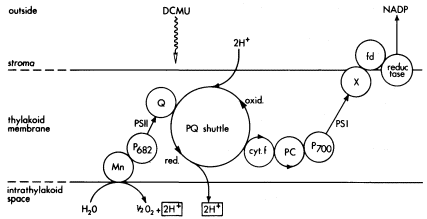Chloroplast Structure
Chloroplast Structure Assignment Help | Chloroplast Structure Homework Help
Chloroplast Structure
Like the mitochondrion, the chloroplast is bounded by two membrances, an outer and an inner membrane with an intermembrane space between them. The inner membrane encloses a stroma space which contains soluble enzymes. In higher plants the stroma contains small cylindrical structures called grana. In spinach each chloroplast contains 40-60 grana, while in tobacco chloroplasts there are 40-80 grana. Most chloroplasts contain 10-100 grana.Each granum consists of disc-haped membranous sacs called thylakoids piled one on top of the other. Regions of the thylakoid membranes in contact with each other are known as the stacked regions, while regions not in contact are known as the unstacked regions. The number of thylakoids in a granum may vary from a few to more than 50.
Chloroplasts thus have three different membrane types, the outer membrane, the inner membrane and the thylakoid membrane. The morphology of mitochondria and chloroplasts is remarkably similar. The outer membranes of both organelles are analogous. The inner membrane of the chloroplasts corresponds to the inner membrane of the mitochondrion without the cristae. Thylakoids can be considered to be analogous to mitochondrial cristae pinched off from the inner membrane.
The outer membrane of the chloroplasts, as with the outer mitochondrial membrane is freely permeable to small molecules. The inner chloroplast membrane is impermeable to small molecules, even to H+. It, however, has tranlocators for a number of compounds for passage of substances across the membrane, both in the inward and outward direction. These substances include dicarboxylic acids, ATP and other organic phosphates.
The thylakoid membrane contains all the enzymatic components required for photosynthesis. Interaction between chlorophyll, electron carriers, coupling factors and other components takes place within the thylakoid membrane. Light energy is used for splitting water to oxygen. Reduction of NADP+ and phosphrylation of ADP take place simultaneously. The resulting products NADPH and ATP, respectively, are utilized by the stroma enzymes which fix carbon dioxide, synthesize and break down strarch, and catalyze the oxidative pentose pathway.

The components of the two photosystems are asymmetrically distributed across the thylakoid membrane, as postulated by Mitchell’s chemiosmotic hypothesis.
The inner surface of the membrane has 18nm boxcar particles which spans the membrane are are visible on both surfaces. The particles are concentrated in the stacked regions of the thylakoid membranes.
Origin. Chloroplasts originate from proplastids. These are small spheres with double membranes. When the proplastids reach a diameter of 1 μ m the inner membrane invaginates to form vesicles in the presence of sunlight. The vesicles become arranged to form a chain of larger discs which are not connected to each other. Fusion of the discs takes place to give rise to thylakoids and stroma lamellae. In conditions of darkness or low light intensity the vesicles of the proplastid aggregate to form one or many primary grana or prolamellar bodies. The vesicles may also form a crystalline lattice consisting of vesicles connected by tubules.
For more help in Chloroplast Structure please click the button below to submit your homework assignment.